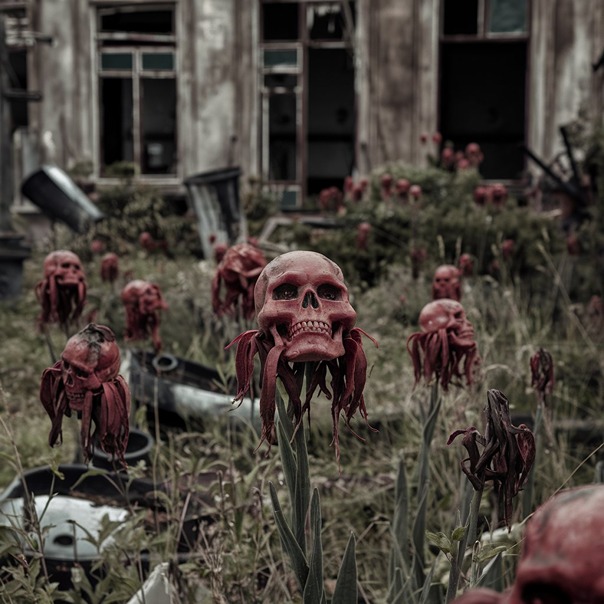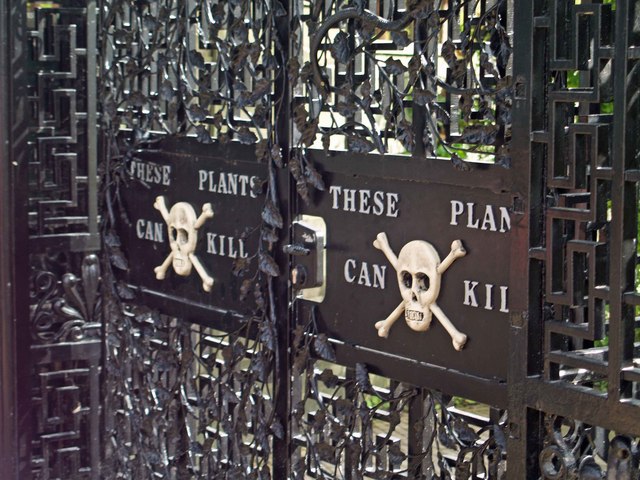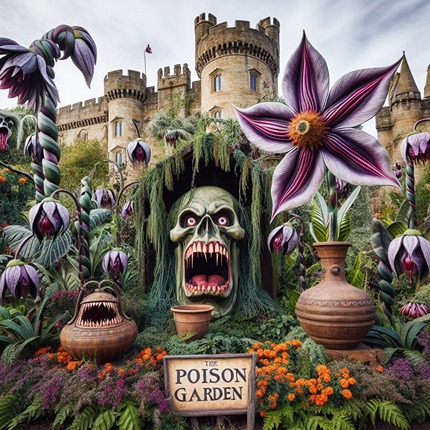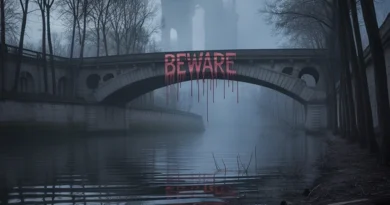In The Poison Garden In Alnwick, Flowers Can Kill You
This happens almost every time I go to buy flowers, usually for my wife. I arrive at the flower shop, look at the different bouquets, try to smell them, and check the prices. And yet, I can’t come to a decision, even when the hapless saleswomen try to help me with some guiding questions, such as “What did you like?” which result in a retarded answer like “Umm. I liked everything.” My average visit to a flower shop is quite long: I’m almost sure that at one point, there were flowers that opened, changed their colors but also died before my eyes, even before I found something to buy. I’m the enemy of the flower sellers, the annoying customer who takes up valuable space in the store, wastes everyone’s time, asks unnecessary questions, but doesn’t decide.
During one of the visits, the shop owner wrote something on a note and handed it to me. “Here, go there and find the flowers you’re looking for,” she announced with a strange smile. “You will die for these flowers.”
I came home excitedly and googled the place the saleswoman mentioned. In a few seconds, my eyes went dark, and I screamed out the word “Freaking Flower Bitch!”. You see, The place the seller sent me to was the Poison Garden in the UK, known as Alnwick Poison Garden. It got its name from the spectacular flowers it contains, with a tiny twist: these colorful flowers can kill you if you don’t follow the safety instructions.
What Is The Poison Garden In The UK?
The Poison Garden location is in Northumberland County, in North East England. The garden, part of the magnificent grounds of Alnwick Castle, was established by Jane Perwas, the Duchess of Northumberland. She visited a similar garden in Italy – the garden of Villa Medici in Faizola, Tuscany – and decided to create a garden with spectacular and colorful plants, with one drawback. Contrary to the pure image of the flowers or their ability to save lives, as in some optimistic children’s books.
💀 Killer Deals & Scary Recommendations 💀
🎭 Costumes & Accessories
HalloweenCostumes Fun Costumes Entertainment Earth
🛒 Online Shopping
AliExpress Amazon Walmart Etsy
🧛 Collectibles & Horror Brands
Funko Hot Topic Lego Spirit Halloween
🎢 Attractions & Tours
GetYourGuide Tiqets Viator Klook
📖 Blogs & Horror Sites
Bloody Disgusting iHorror Fangoria
🩸 Disclaimer: Some links are affiliate links. The price stays the same – it just helps keep the site alive 👻
Why Was The Poison Garden Created?
We believe Alnwick Poison Garden’s history starts as early as 1750. Over the years, the Dukes of Northumberland have been fond of the garden but needed to figure out what to do with it, which was neglected. The change came in the 21st century when Duchess Jane Percy decided to turn the garden into an attraction. She wanted to create a garden different from what you can find in other similar locations, one that would offer added value to botany enthusiasts.
In 2005, they added a garden with poisonous or narcotic plants, and their catalog has only grown since then. Beyond the appeal of Jane Percy for poisonous flowers, the Duchess was also looking for ones with a story. And if they can look pretty, it will also be fantastic.
What Plants Are In The Poison Garden?
The danger in the poison garden stems from the poisonous nature of the plants displayed in it. Many of these plants contain potent toxins that can cause severe allergic reactions, illness, and even death in case of contact or ingestion. Some plants are grown in special cages to avoid any possible contact with visitors.
Today you can find over 100 species of flowers, plants, and trees that are dangerous to humans and, of course, to other living creatures as well, including:
🥀 The Vomiting Nut, or “Strychnos nux-vomica” – This is a large white fruit with a grapefruit, the size of an apple. The seeds of the fruit are bitter and very poisonous (for example, they contain the ingredient strychnine, which we can find in rat poison). You will be surprised, but over the years, many have used this fruit for various medical purposes, such as the treatment of facial paralysis, the treatment of epilepsy, and, as can be inferred from its name, encouraging vomiting in situations that require it.
🥀 Castor Bean (Ricinus Communis) – a green shrub or tree from the Habloviaceae family, which is considered particularly deadly: even chewing a single seed can cause the death of an adult, while for a child, even one grain is enough. Ricinus Communis may also be dangerous by contact (for example, rubbing the skin with the juice of the seeds). They may cause inflammation, eye damage, skin irritations, and more.
🥀 Belladonna (Atropa belladonna) – The name “Belladonna” means “beautiful woman,” since in the past, women dripped a few drops of the flower essence into their eyes to dilate their pupils. The plant, and especially its root, contains toxins that can trigger symptoms such as hallucinations, confusion, or even death.
When you look at the type of plants and the vision of the garden, you can conclude that contrary to what you might expect in a horror movie (whether real or one that takes place in the head of a specific person. According to the first paragraphs of this article), the goal here is not to scare the visitors, nor to send helpless people to their deaths (“that bitchy flower girl!”).
Instead, The garden was meant to educate, to present a topic that many people are not aware of, to show the various uses of plants (both beneficial and harmful), and to raise awareness of the threatening power of nature, if you can be a little bombastic.

The Scary Aspects Of Alnwick Poison Garden
At first glance, this lovely garden looks like an ordinary botanical garden, impressive by any standard. It is certainly well maintained, as it befits a garden whose development cost is by a pair of well-known Belgian landscape architects, Jacques and Peter Wirtz. With a reported development cost of around 42 million pounds, this is one of the most ambitious projects in the field that arose in Britain after the Second World War.
The development was done in several stages, starting in 2001. It included the construction of a waterfall, the initial planting of gardens, the construction of a large wooden house complex (including a cafe), a pavilion, a visitor center that stands out with its rounded arched roof, designed gates, and many plants. Some are scattered in the safe parts of the Ennick Garden, while others are in the Toxic Garden.
Interestingly, but not surprisingly, the ambitious project received several reviews. Some argued that it was an excessive waste of money, and botanical experts also criticized some of the decisions of the Duchess and her partners.
Do You Want To Live? Please Behave Accordingly
The problem is that this is no ordinary botanical garden. If in standard gardens visitors can walk independently, in The Poison Garden, you can only visit as part of an organized tour, during which you learn about the garden’s history, the specific plants in The Poison Garsen, and how they may harm you. Throughout the garden, you will find black and barred gates, with the inevitable painting of the skull and bones in places that are dangerous to visit and the inscription “These Plants Can Kill.”

Some rules are necessary to follow inside The Poison Garden, and most of them should not surprise you when you look at which plants are here:
🥀 It is forbidden to touch the plants and, of course, to pick them. Even light skin contact can cause allergic reactions and other problems.
🥀 Do not eat plants, even if it looks tempting. This warning regards the leaves, flowers, fruits, or seeds.
🥀 The tours occur only in a guide’s presence; staying close to him is essential.
🥀 If visiting with children, keep them close and ensure they understand the rules.
🥀 Entry with pets is prohibited. If you’ve ever walked a dog in a garden full of flowers, you can understand why
If you follow the rules, there should be no health problems. In any case, if you feel physical symptoms after the visit, it is crucial to seek help and inform the care provider about the possible exposure.
Tours In The Poison Garden – Everything You Need To Know
Tours of England’s Poison Garden last 20-30 minutes and depart every half hour, within the garden’s operating hours. The tickets include the visit to the complex, but it is crucial to ensure that the tours are available during your visit because they are limited to up to 20 participants per tour.
One of the main attractions in the complex for children is the Lilidorei, an enormous play structure (the site states that it is the largest structure of its kind in the world). You will also find a rose garden (non-toxic!), tree house, mini golf complex, cafe, and more here.
There is an Alnwick Poison Garden gift shop, which luckily does not offer poisonous plants. Instead, you will find souvenirs inspired by the garden and the world of toxic plants, with one of the highlights being The Poison Garden book with the super short name “The Alnwick Garden – The Poison Garden Alnwick A-Z of Poisonous Plants – The Deadly, Dangerous and Down Right Bizarre,” which is The Alnwick Poison Garden plant list.
The Alnwick Castle Opening Hours
The opening hours of the Poison Garden and the more expansive complex of Alnwick Castle vary throughout the year according to demand and different dates in the tourist calendar.
Most of the year, the garden is open daily from 10:00 to 17:00.
Ticket Types And Combinations
You can choose between several types of tickets, where the price depends on several parameters:
- The date of the order: tickets for purchase in advance will be cheaper compared to tickets bought on the spot
- Day of visit: similar to many other attractions, even in the case of the Poison Garden, the price on weekends will be a little more expensive than during the middle of the week
- Basic card vs. a card with a small gift (Gift Ait)
- Age – not surprisingly, a ticket for a child (3-16) will be cheaper than an adult ticket. Please note that children up to two years old enter for free.
On the official website of the gardens, you will find a breakdown of the types of tickets and their cost.
Where Can You Buy Tickets For The Poison Garden?
Box Office
There are several options for purchasing tickets for the Poison Garden and Alnwick Castle Gardens. As always, you can buy tickets at the box office upon arrival at the venue. The disadvantage is that no one guarantees you that you will have a spare ticket at the time of your visit (especially if you intend to join the tour, as you must do at the Poison Garden), that you will have to stand in lines and that the prices may be higher.
Official Website
The next option is through the Castle’s website. The advantages are that buying through the official website is inherently safe, and you can reserve a place on a specific date. The downside is that the tickets are non-refundable here. In addition, when you purchase tickets from the website, it is impossible to change the dates of the tickets purchased in the current period.
Online Tickets Website
You can buy tickets on prominent attraction websites like Get Your Guide and Viator. The advantages are that from the examination we made, the prices are similar compared to the official website, what’s more, here there is also the option of free cancellation up to 24 hours before the reservation date of the tickets – a commodity that has become mandatory from the point of view of Many tourists in the current period. Along with the option to buy tickets to the complex, including a guided tour of the Poison Garden, it is sometimes offered as part of broader day trips, for example, trips that depart from Edinburgh in Scotland.
Here are some of the tours that includes The Alnwick Castle, and The Poison Garden:





